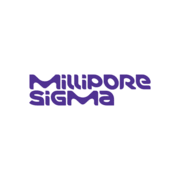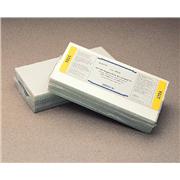TLC Plates
-
 Cellulose plates (TLC and HPTLC)
MilliporeSigma
Cellulose plates (TLC and HPTLC)
MilliporeSigmaFor analysis of polar substances The organic sorbent cellulose is particularly suitable for the separation of hydrophilic substances by partition chromatography. EMD Millipore cellulose plates include classical TLC grade or HPTLC plates for demanding high-performance separations: TLC…
-
-
PLC Silica Gel 60 RP-18 F254s, 1 mm
MilliporeSigmaPLC plates allow users to separate samples that vary greatly in size – from grams down to milligrams. Available with or without a fluorescence indicator, PLC plates has 1mm thickness. They also use the same proven EMD Millipore silica-binder technology as in analytical TLC plates. To isolate the…
-
TLC Silica Gel 60 RP-18 F254s
MilliporeSigmaRP modified plates serve two purposes: act as a pilot method for HPLC and allow to choose various solvent system for special separations. RP-modified silica layers from EMD Millipore are well suited for many separation challenges that unmodified silica cannot overcome. These layers use aqueous…
-
10 cm Developing Tank
General Glass BlowingFlat ground top is beveled on the inner and outer rim Ground flat bottom for stability Holds two 10 x 10 cm plates or four 5 x 10 cm plates Thin-Line units allow for faster and more uniform solvent saturated atmosphere and therefore require less solvent. Inside dimensions: 12 x 6.4…
-
Silica Gel G UNIPLATES
Miles Scientific (Analtech)Silica Gel G & GF UNIPLATES are the most widely used silica gel TLC plates. No organic substances are added to these products, thus making them compatible with sulfuric acid charring visualization.These plates are commonly scraped from the glass backing to isolate separated components for other…
-
Nano-DURASIL Unmodified HPTLC Silica Layers
MACHEREY-NAGELFeatures Nano silica 60, specific surface (BET) ~ 500 m2/g, mean pore size 60 Å, specific pore volume 0.75 mL/g, particle size 2–10 µm Indicator: manganese activated zinc silicate with green fluorescence for short-wave UV (254 nm) Hard, water-resistant and wettable…
-
TLC Developing Tank
DWK Life Sciences (Kimble)Constructed of sturdy molded glass bricks Withstands regular use for many years The tank’s clear sides allow for visual inspection of TLC plates up to 20 x 20 cm size. The top of the tank is ground flat to match the lids and the edges are beveled to remove any sharp edges. The bottoms are…
-
TLC Silica gel 60 F254
MilliporeSigmaEMD Millipore classical silica TLC plates are based on a combination of proven EMD Millipore silica gel 60 and the addition of a unique polymeric binder resulting in a very adherent and hard surface that will not crack or blister and even allow writing with a pensil on the surface without risk to…
-
 Glass TLC Plates
MilliporeSigma
Glass TLC Plates
MilliporeSigmaFor thin layer and preparative layer chromatography Ready-to-use Layer thickness 0.25 mm Allow safe spotting without layer damage Plates have a uniform, abrasion-resistant coating and a patented, inert, hard-layer binder that is chip and abrasion-resistant. F254 is a…
-
HPTLC Silica gel 60 F254
MilliporeSigmaPlates deliver fast and quantitative analysis of complex samples for manual or automated use. EMD Millipore’s HPTLC silica plates work three times faster than conventional TLC plates – and they’re more sensitive. The particle sizes range in HPTLC is between 4-8µm, which creates a smoother surface…
-
Latch-Lid Chromatotank Unit
General Glass BlowingClear glass sides allow unobstructed visual inspection of contents Tank is ground flat to match ground glass lid. Beveled inside and outside to remove any sharp edges. Holds two 20 x 20 cm plates or four 10 x 20 cm plates. Latching device holds the matching ground glass surfaces of the lid…
-
-
TLC SILICA GEL 60 100 GLASS PLATES 2.5 X 7.5 CM
MilliporeSigmaEMDMilliporeclassical silica TLC plates are based on a combination of proven EMD Milliporesilica gel 60 and the addition of a unique polymeric binder resulting in a very adherent and hard surface that will not crack or blister and even allow writing with a pensil on the surface without risk to…
-
TLC Cellulose
MilliporeSigmaPlates are used to analyze polar substances. An organic sorbent, cellulose is perfect for separating hydrophilic substances by partition chromatography. Typical applications include the analysis of amino acids, carbohydrates, and phosphates as well as nucleic acid and nucleic acid derivatives. EMD…
-
Unique HPTLC Lichrospher® plates are the first thin layer chromatography plates based on spherical silica particles. They offer the ultimate in thin layer chromatography performance and speed enabling high throughput analysis of complex samples.
-
These plates allow users to quickly and easily apply any kind of sample, even large volumes of diluted samples. EMD Milliporeconcentrating zone plates are based on different adsorption properties of two adsorbents. The first is a large pore concentrating adsorbent where the samples are applied; the…
-
TLC Silica Gel 60 F254 Multiformat Pre-scored to 5 x 10 cm
MilliporeSigmaPre-scored glass plates fold into smaller formats with just one easy snap of the fingers. HS Code: 3822 00 00
-
TLC Silica gel 60 F254 GLP
MilliporeSigmaThese plates feature individual laser coding for GLP applications. Designed for GLP applications, the tops of each of these plates bear an item, batch, and individual plate number. As a result, lab professionals can easily record and archive every plate they use. Based on proven EMD Millipore…
-
TLC Aluminium oxide 60 F254, basic
MilliporeSigmaAluminiumoxide plates are used to analyze basic and neutral compounds at different pH levels. Depending on the pH range in question, professionals can choose between two kinds of aluminum oxide plates. Under aqueous conditions, basic aluminum oxide plates are best for separating basic compounds,…
-
TLC SILICA GEL 60 W 25 ALUMINIUM SHEETS 20 X 20 CM
MilliporeSigmaEMD Millipore classical silica TLC plates are based on a combination of proven EMD Millipore silica gel 60 and the addition of a unique polymeric binder resulting in a very adherent and hard surface that will not crack or blister and even allow writing with a pensil on the surface without risk to…
-
HPTLC Silica gel F254 GLP
MilliporeSigmaFeatures individual laser coding for GLP applications. Designed for GLP applications, the tops of each of these plates bear an item, batch, and individual plate number. As a result, lab professionals can easily record and archive every plate they use. Based on proven EMD Millipore silica found in…
-
DURASIL Unmodified Standard Silica Layers for TLC
MACHEREY-NAGELFeatures Silica 60, specific surface (BET) ~ 500 m2/g, mean pore size 60 Å, specific pore volume 0.75 mL/g, particle size 5–17 µm Hard, water-resistant and wettable layers due to a special binder system No reversed phase tendency, more polar than SIL G Available as…
-
Baker-flex® Coated TLC Silica Gel Sheets
Avantor - J.T.Baker®Ready-to-use plastic sheets, 50 x 200 mm or 200 x 200 mm, with absorbent coating, which is abrasion-resistant and highly uniform; are easily cut to desired size and allow sample fraction to be cut rather than scraped The silica gel and aluminum oxide sheets have coating approximately 200 microns…
-
PLC SILICA GEL 60, 0.5 MM 20 GLASS PLATES 20 X 20 CM
MilliporeSigmaPLC plates allow users to separate samples that vary greatly in size – from grams down to milligrams. Available with or without a fluorescence indicator, PLC plates has 0.5 mm thickness. They also use the same proven EMD Millipore silica-binder technology as in analytical TLC plates. To…
-
Glass-Backed Analytical TLC Plates
Miles Scientific (Analtech)This TLC plate can be developed using purely organic, organic/aqueous, and purely aqueous mobile phases. Due to this these plates have been used in numerous applications in normal phase chromatography as well as reversed phase chromatography. Common applications include the analysis of active plant…
-
TLC Cellulose
MilliporeSigmaThese cellulose plates are used to analyze polar substances. An organic sorbent, cellulose is perfect for separating hydrophilic substances by partition chromatography. Typical applications include the analysis of amino acids, carbohydrates, and phosphates as well as nucleic acid and nucleic acid…
-
TLC Cellulose F
MilliporeSigmaCellulose plates are used to analyze polar substances. An organic sorbent, cellulose is perfect for separating hydrophilic substances by partition chromatography. Typical applications include the analysis of amino acids, carbohydrates, and phosphates as well as nucleic acid and nucleic acid…
-
ProteoChrom® HPTLC Cellulose Plate
MilliporeSigmaWe’ve enhanced our ProteoChrom® plates to make separation highly efficient – especially when peptides and protein digests need to be analyzed. ProteoChrom® plates take performance to new levels. Applications are highly reproducible thanks to optimized separation and staining procedures. With…
-
TLC Cellulose
MilliporeSigmaCellulose plates are used to analyze polar substances. An organic sorbent, cellulose is perfect for separating hydrophilic substances by partition chromatography. Typical applications include the analysis of amino acids, carbohydrates, and phosphates as well as nucleic acid and nucleic acid…
-
TLC Silica gel 60 F254
MilliporeSigmaClassic silica TLC plates are based on a combination of proven EMD Millipore silica gel 60 and the addition of a unique polymeric binder resulting in a very adherent and hard surface that will not crack or blister and even allow writing with a pensil on the surface without risk to damage the layer.
-
Baker-flex® Coated TLC Cellulose Sheets
Avantor - J.T.Baker®Ready-to-use plastic sheets, 50 x 200 mm or 200 x 200 mm, with absorbent coating, which is abrasion-resistant and highly uniform; are easily cut to desired size and allow sample fraction to be cut rather than scraped The silica gel and aluminum oxide sheets have coating approximately 200 microns…





























